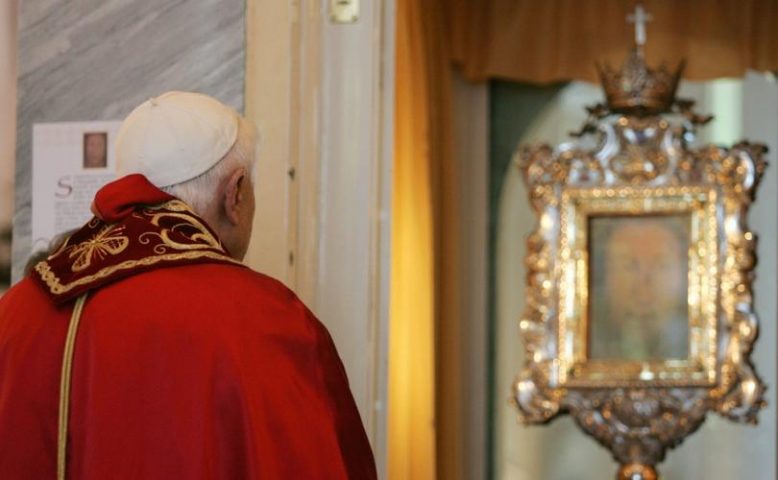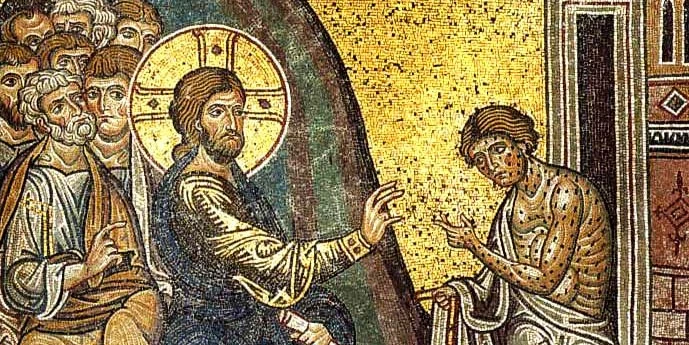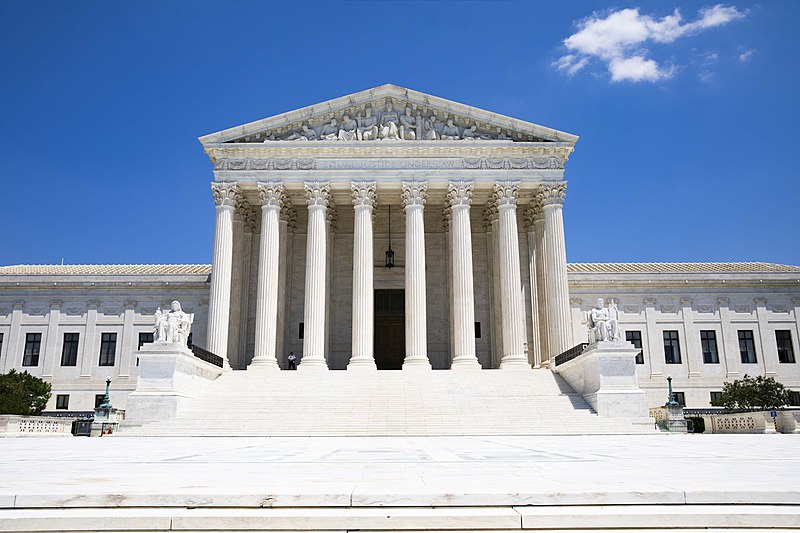How a Miraculous Image of Jesus’ Face May Have Thwarted St. Gallen Mafia at 2005 Conclave

Five Times President Trump Has Worked to Defund the Planned Parenthood Abortion Business
December 8, 2018
Msgr. Charles Pope: The Most Important Things at Christmas (Video)
December 8, 2018
Pope Benedict XVI looks over a mysterious icon that many believe shows the face of Christ, Manoppello, Sept. 1, 2006.Max ROSSI/AFP/Getty Images
By Maike Hickson, LifeSiteNews, December 7, 2018
The journalist and book author Paul Badde, who lives in Rome and works for EWTN, has worked for years on the history and significance of an ancient relic that has been cherished by Christianity for a long time, but had been lost for some centuries: The Holy Face of Manoppello – which is believed be a miraculous picture of Our Lord at the moment of His Resurrection.
Badde has written several books on this holy image which is now being kept in a monastery in Manoppello, Italy, and which Saint Padre Pio himself allegedly visited, in bilocation, and not long before he died. Padre Pio called this relic depicting the face of Jesus, “the greatest miracle we have.”
 Holy Face of Manoppello
Holy Face of Manoppello
LifeSiteNews conducted an interview with Paul Badde because he has just published in English a new booklet which sums up the recent developments and findings concerning this relic, which includes the prominent and public support of this relic and its authenticity by Archbishop Georg Gänswein, Pope emeritus Benedict XVI’s secretary.
LifeSiteNews already published a book review of this booklet when it first appeared this year in German. The book review can be read here. However, the English version, as now published by Sophia Press, contains some additional information.
In this new interview, Paul Badde reveals how intensely the Holy Face of Manoppello – or the Volto Santo, as the Italians call it – is involved in the Church’s recent history. Paul Badde shows, for example, how Cardinal Joachim Meisner visited the Holy Face only a short time before the 2005 Conclave. At that Conclave, with Paul Badde’s help, Cardinal Meisner was able to show his fellow cardinals that there then existed an attempt – by people such as Cardinal Achille Silvestrini, Cardinal Walter Kasper, Cardinal Karl Lehmann, Cardinal Godfried Danneels, Cardinal Murphy-O’Connor, Cardinal Audrys Juozas Bačkis, and Cardinal Carlo Martini – to prevent Joseph Ratzinger’s election. As Badde then heard it, they had intended Cardinal Martini’s election. During that same Conclave, however, he also later heard in Rome the name Jorge Bergoglio mentioned.
 Detail of Holy Face of Manoppello
Detail of Holy Face of Manoppello
Cardinal Meisner succeeded in his struggle – with a picture of the Holy Face kept in his pocket – and Joseph Ratzinger became Pope. The rest is history.
Later, Paul Badde found out that this group of cardinals working against Ratzinger was the so-called “Sankt Gallen Group.”
***
Full interview with Paul Badde:
LifeSiteNews: You have already written extensively about the Holy Face of Manoppello. What is the reason that you wrote yet another book on this topic? Has there come forth new evidence about its veracity?
Paul Badde: You are right, it is the fourth book I have written about the Holy Face of Manoppello, along with innumerable articles. I also made two films for EWTN about the Face of God. The main reason to write this new book, however, is that Pope Benedict XVI has prompted an entirely new development in research and the rediscovered significance regarding the Sanctissimum Sudarium (as it was formerly called in Rome) after he visited the Holy Veil on 1 September, 2006 — he was the first pope to do so after more than 400 years. In my former books, I have presented a good number of arguments for the evidence about the veracity of the Holy Veil. With this book, I would like to invite the readers again to become pilgrims to the Face of God in Manoppello, where they will experience that this sacred arch-icon of the Lord is a form of pure evidence in itself. It is as if we would follow the Apostle Philipp in the Gospel when he said to Nathaniel: “Come and see!”
LifeSiteNews: What would you tell someone who is new to this topic: what are the main reasons to believe that the Volto Santo is truly the Face of Jesus Christ when He walked this earth?
Paul Badde: What I keep telling everybody is exactly this: “Come and see!”
LifeSiteNews: It was the private secretary of Pope Benedict XVI, Archbishop Georg Gänswein, who not long ago participated in a public procession with a copy of the Holy Face in Rome, a procession that was done the first time in the year 1208. What was his message presented in his homily?
Paul Badde: Yes, that’s right. But to start with, I would like to say this: Some weeks ago Archbishop Georg Gänswein presented here in Rome Rod Dreher’s Book The Benedict-Option in the Italian Parliament where he called the actual crisis another nine/eleven in the Church.
What I found more amazing, however, was that he used the term “eclipse of God” to identify the inner character of the catastrophe we are experiencing in these days.
It is an expression which has been used by Pope Benedict time and again and which stems from the Jewish philosopher Martin Buber if I recall it correctly. And here we should not forget that the eclipse of the sun means that the shadow of our planet earth is projected onto the sun. It doesn’t mean that the sun doesn’t exist.
So in analogy to that eclipse of the sun, also the eclipse of God, doesn’t mean that God doesn’t exist. It means a shadow is cast on Him so that we can’t see Him for the time being. And in our times, that’s clear, it is the satanic shadow of the sins by the Church that makes God nearly invisible to us.
But God still exists, of course. And this is exactly the time when the Holy Face now reappears in the United States, where the Catholic Church is haunted by the news of so many troubles and sins and crimes committed by priests.
And now He reappears behind the clouds of sins again, telling us, beyond all the shadows: “Look, It’s Me, I became Man, as you can see, I was tortured and killed like a lamb and died (to take away the sins of the earth). Then I rose from the dead, alive forever. Don’t be afraid, for all is true that you heard about me: Truth alone will prevail, not the lie, nor sin.”
As to your initial question, though, I have to tell you that it was precisely Archbishop Gänswein, the secretary of Benedict XVI, who started, as I said, on the vigil of Sunday, 16 January 2016, in the Parish Church of Santo Spirito in Sassia (close to Saint Peter’s) a new tradition of venerating the Holy Face (again), when he introduced a new feast on the day “Omnis Terra”, which is the second Sunday after the Feast of Epiphany, remembering the day in 1208 when Pope Innocent III. had first shown the Holy Veil in public in the Latin Church of the West.
Prior to the Solemn Mass presided over by Archbishop Gänswein, a big group of citizens from Manoppello had brought a copy of the Holy Face to Rome where they had carried it in a solemn procession first to Saint Peter’s and then from there to Santo Spirito in Sassia, headed by the former Nuncio, Archbishop Edmond Farhat of Lebanon. In his homily Archbishop Gänswein declared on that unique occasion, there follows, among other things:
This Sunday is called Omnis Terra with the words of Psalm 65. Omnis terra adoret te, Deus, et tibi psallat! That means: ‘All the earth worships You, O God, and sing psalms for You!’ This psalm was sung here also eight hundred years ago; and even then, as today, the Gospel of the wedding feast of Cana was proclaimed in Catholic churches around the world. Empires have fallen since then, swept away like autumn leaves; the Church saw the continuous succession of ninety-two popes. Violent revolutions and wars have shaken Europe; fatal divisions have lacerated Christianity. So the tranquility seems like a miracle with which, in the liturgy of this Sunday, we sing today as then: Praise the Lord, all peoples!
It is with this sense of jubilation that we now remember that Pope Innocent III had this holy sudarium carried from St. Peter’s to Santo Sasso eight hundred and eight years ago. […]
[It is the holy image which the Pope] showed to the pilgrims and which for more than four hundred years has been preserved in Abruzzo, near the Adriatic Sea, in an outlying area of Italy, and which for the first time was brought back to where its public worship began in Rome. From here, innumerable copies have spread the Christian awareness of the existence of a true The Holy Face and Veil throughout the world. In this lies the deepest meaning of this moment. Before coming to Rome, the Sacred Veil was guarded in Constantinople, prior to that it was in Edessa, and even earlier it had been in Jerusalem. This face cannot be the property or the jealous treasure of one place, one church, or one owner, not even of the popes. It is the ‘trademark of Christians.’ It is only we who know that God has a face; only we know who and how He is. For this reason, the face of Christ is the most noble and precious treasure of all Christianity, indeed of all the earth, omnis terra! To this face we have to set out ever anew—always as pilgrims; always to areas of the periphery of our conception. And always having only one goal in front of us: the moment we will face him face-to-face. Amen.




